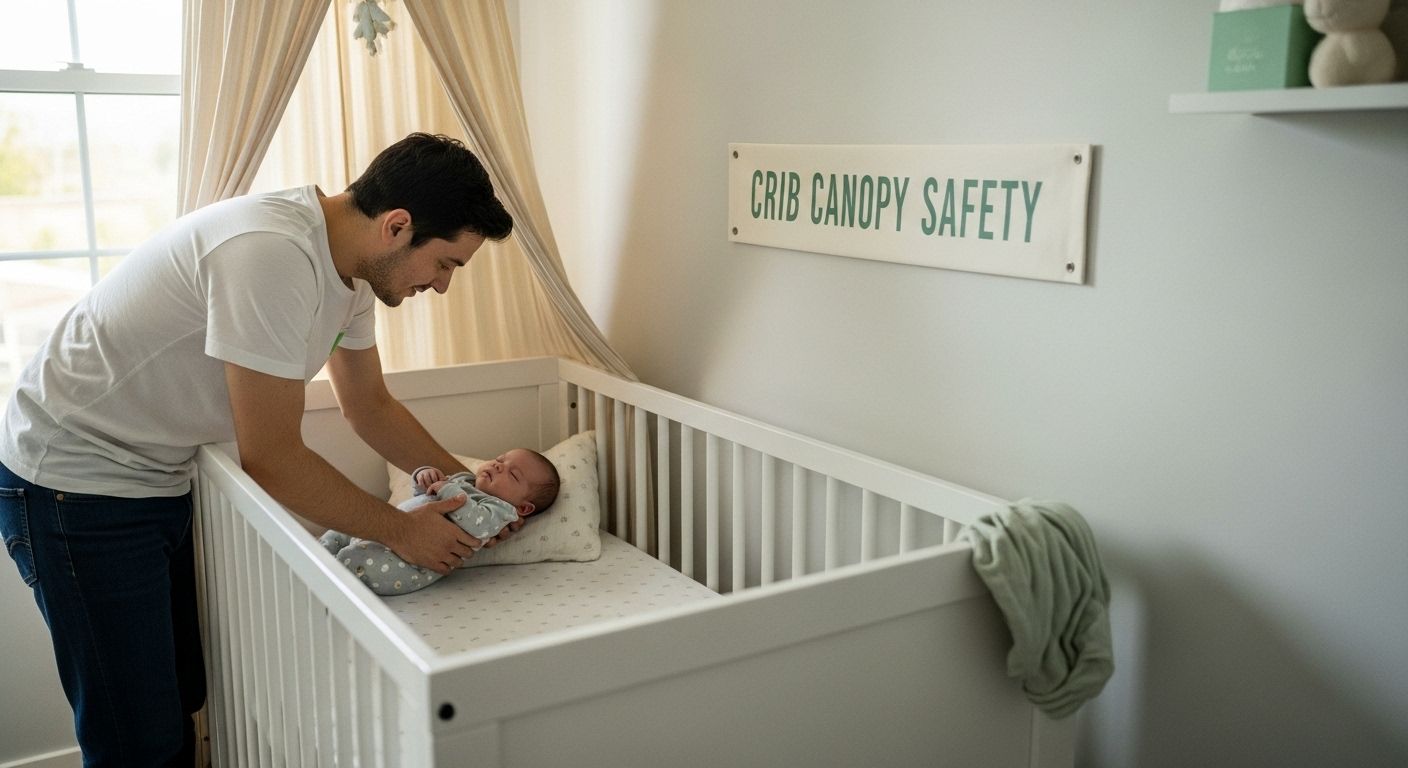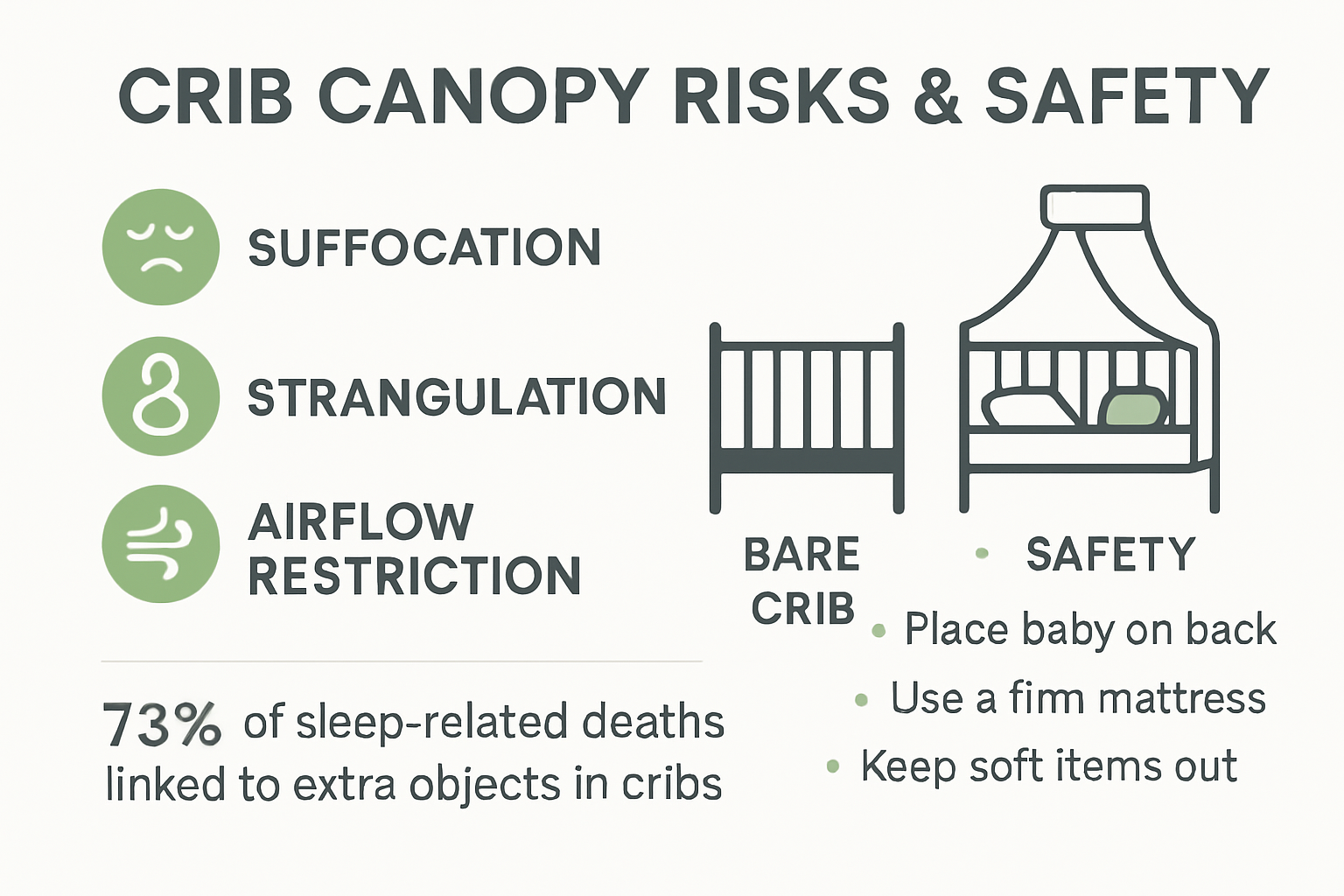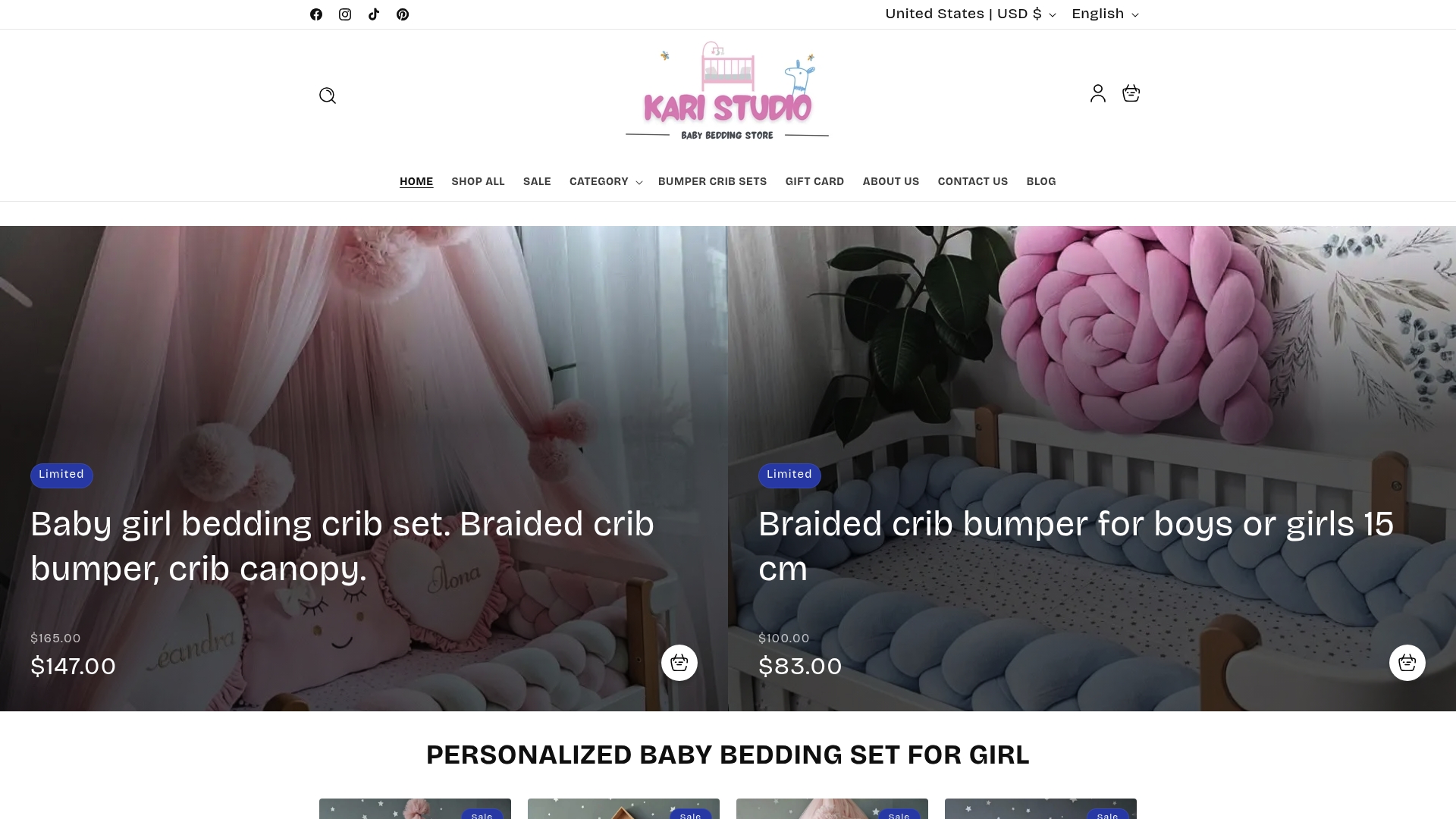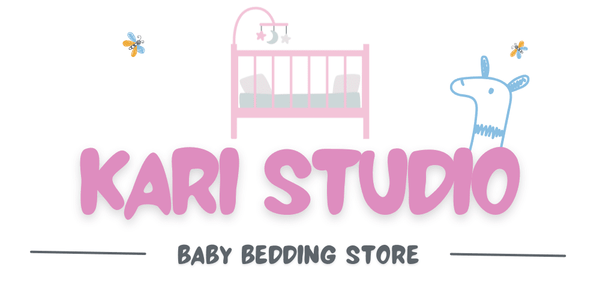Betthimmel verwandeln das Kinderzimmer im Handumdrehen und verleihen dem Schlafbereich jedes Babys ein traumhaftes und stilvolles Aussehen. Doch auch wenn Ihnen die Optik gefällt, warnen die meisten Sicherheitsexperten, dass diese schönen Vorhänge auch versteckte Gefahren bergen.

Tatsächlich passieren über 70 Prozent der schlafbedingten Todesfälle bei Säuglingen durch hinzugefügte Gegenstände oder lose Materialien im Kinderbett , und ein Baldachin kann weitaus riskanter sein, als es scheint.
Inhaltsverzeichnis
- Was ist ein Kinderbetthimmel und wozu dient er?
- Warum die Sicherheit von Kinderbetthimmeln für Kleinkinder wichtig ist
- Wie sich Kinderbetthimmel auf die Schlafumgebung und Sicherheit auswirken
- Wichtige Sicherheitsmerkmale, auf die Sie bei Kinderbettüberdachungen achten sollten
- Häufige Risiken und deren Minderung
Kurze Zusammenfassung
| Wegbringen | Erläuterung |
|---|---|
| Halten Sie Kinderbetten frei von Zubehör | Legen Sie zur Sicherheit des Säuglings nur ein Spannbettlaken in das Kinderbett und halten Sie sich an die Empfehlungen von Experten. |
| Vermeiden Sie vollständig Betthimmel | Überdachungen bergen erhebliche Risiken wie Erstickungs- und Strangulationsgefahr, die den ästhetischen Nutzen überwiegen. |
| Fokus auf Luftstrom und Belüftung | Um Atemproblemen vorzubeugen und eine sichere Schlafumgebung zu gewährleisten, ist es wichtig, für eine ausreichende Luftzirkulation zu sorgen. |
| Die Sicherheit des Kleinkinds hat Vorrang vor der Dekoration | Ein minimalistischer Schlafplatz ist für die Sicherheit des Säuglings unerlässlich und dekorative Elemente sollten dies nicht beeinträchtigen. |
| Verstehen Sie potenzielle Entwicklungsrisiken | Zubehör wie Betthimmel können den natürlichen Schlafrhythmus und die Sinneswahrnehmung stören und sich so auf die allgemeine Entwicklung des Säuglings auswirken. |
Was ist ein Kinderbetthimmel und wozu dient er?
Ein Betthimmel ist ein dekoratives und funktionales Accessoire, das den Schlafbereich eines Säuglings teilweise abdeckt. Er besteht in der Regel aus leichtem Stoff und wird über dem Bettchen aufgehängt. Obwohl dieses Zubehör optisch ansprechend ist, erfordert es sorgfältige Überlegungen hinsichtlich der Sicherheitsvorschriften und möglicher Risiken.
Das Design von Kinderbetthimmeln verstehen
Betthimmel gibt es in verschiedenen Ausführungen, von minimalistischen Stoffvorhängen bis hin zu aufwendigeren, moskitonetzartigen Strukturen. Traditionell werden diese Accessoires von Eltern aufgrund ihrer vielfältigen Vorteile geschätzt:
- Schaffen Sie eine gemütliche, abgeschlossene Schlafumgebung
- Blockieren von überschüssigem Licht während des Mittagsschlafs
- Verleihen Sie der Kinderzimmerdekoration einen ästhetischen Reiz
- Potenziell reduzierte visuelle Stimulation bei Säuglingen
Untersuchungen der US-amerikanischen Verbraucherschutzbehörde Consumer Product Safety Commission raten jedoch dringend davon ab, zusätzliche Gegenstände in den Schlafräumen von Kleinkindern zu verwenden, da erhebliche Sicherheitsbedenken bestehen.
Sicherheitsaspekte für Kinderbetthimmel
Eltern müssen sich darüber im Klaren sein, dass die Schlafumgebung von Kleinkindern frei von zusätzlichen Gegenständen sein sollte . Die wichtigste Empfehlung von Kindersicherheitsexperten ist, das Kinderbett leer zu lassen und nur ein Spannbettlaken zu verwenden. Betthimmel können trotz ihrer Ästhetik ernsthafte Risiken bergen:
- Potenzielle Strangulationsgefahr durch Stoff oder Befestigungsmechanismen
- Gefahr, dass Stoff in das Kinderbett fällt und das Gesicht des Säuglings bedeckt
- Mögliche Beeinträchtigung der Luftzirkulation
- Kompromiss bei Empfehlungen für sicheren Schlaf
Laut Nationwide Children's Hospital sollten Eltern der Sicherheit ihres Babys Vorrang vor dekorativen Elementen geben. Das Grundprinzip bleibt klar: Nichts sollte die Schlafumgebung eines Babys behindern oder beeinträchtigen .
Auch wenn Kinderbetthimmel charmant wirken, überwiegen die potenziellen Risiken bei weitem die ästhetischen oder funktionalen Vorteile. Eltern wird dringend empfohlen, einen sicheren, ungehinderten Schlafplatz zu schaffen, der den Empfehlungen professioneller Ärzte entspricht.
Warum die Sicherheit von Kinderbetthimmeln für Kleinkinder wichtig ist
Die Sicherheit von Kleinkindern ist für Eltern ein wichtiges Anliegen. Um eine sichere Schlafumgebung zu schaffen, ist es wichtig, die potenziellen Risiken von Kinderbettzubehör wie Himmeln zu kennen. Schon die scheinbar harmlose Verwendung eines Stoffbezugs kann erhebliche Gefahren bergen, die die meisten Eltern nicht sofort erkennen.
Unmittelbare körperliche Risiken
Betthimmel bergen für Säuglinge zahlreiche direkte körperliche Gefahren. Weiche Stoffe und lose Materialien bergen erhebliche Erstickungs- und Strangulationsrisiken . Fällt ein leichter Stoff in das Bett, kann er das Gesicht des Säuglings bedecken und innerhalb von Sekunden die Atemwege blockieren. Säuglingen fehlen die motorischen Fähigkeiten und die Kraft, solche Hindernisse zu beseitigen, was diese Situationen besonders gefährlich macht.
Zu den wichtigsten physischen Risiken gehören:
- Mögliche Verwicklung des Stoffes um Hals oder Gliedmaßen
- Reduzierte Luftzirkulation im Schlafbereich
- Möglichkeit, dass der Stoff auf das Kind fällt
- Entstehung unerwarteter Druckpunkte
Um den Lesern einen schnellen Vergleich und ein Verständnis der verschiedenen körperlichen, entwicklungsbezogenen und strukturellen Risiken zu ermöglichen, die mit Kinderbetthimmeln verbunden sind, finden Sie hier eine Übersichtstabelle mit den wichtigsten Punkten des Artikels:
| Art des Risikos | Beschreibung | Beispiel aus dem Artikel |
|---|---|---|
| Sofortige körperliche | Risiken, die den Körper oder das Leben des Säuglings direkt schädigen können | Ersticken, Strangulation durch Verwickeln |
| Entwicklungs- und Langzeit | Risiken, die eine gesunde Entwicklung stören oder das SIDS-Risiko mit der Zeit erhöhen können | Unterbrochener Schlafrhythmus, beeinträchtigte Thermoregulation |
| Luftstrom/Atmung | Gefahren, die die Atemwege und die Luftqualität beeinträchtigen | Reduzierter Sauerstoffaustausch, CO2-Ansammlung |
| Strukturell/Mechanisch | Gefahren durch mechanisches Versagen oder Materialschäden am Schirmdach oder dessen Befestigungen | Gewebekollaps, Versagen der Befestigungspunkte |
| Psychologisch/sensorisch | Potenzial für sensorische Überlastung oder Störung der natürlichen sensorischen Entwicklung | Visuelle Überstimulation, Angstzustände, unterbrochene Schlafzyklen |
Auswirkungen auf die Entwicklung und die langfristige Sicherheit
Untersuchungen des National Institute of Child Health and Human Development unterstreichen, dass eine sichere Schlafumgebung für die Entwicklung von Säuglingen von entscheidender Bedeutung ist . Unnötiges Zubehör wie Betthimmel kann die sorgfältig empfohlenen Schlafbedingungen stören, die Säuglinge in ihren empfindlichsten Entwicklungsphasen schützen sollen.
Zu den potenziellen langfristigen Sicherheitsbedenken zählen:
- Erhöhtes Risiko für den plötzlichen Kindstod (SIDS)
- Mögliche Atemwegskomplikationen
- Unterbrechung des natürlichen Schlafmusters
- Beeinträchtigte Wärmeregulierung
Professionelle medizinische Empfehlungen
Kindersicherheitsexperten empfehlen allgemein, die Schlafumgebung für Säuglinge minimalistisch zu gestalten. Das sicherste Kinderbett enthält lediglich eine feste Matratze und ein Spannbettlaken. Alle zusätzlichen Gegenstände, einschließlich dekorativer Betthimmel, stellen unnötige Risiken dar und können die Sicherheit des Säuglings gefährden.
Eltern sollten Wert darauf legen , einen freien Schlafplatz zu schaffen , der eine gute Luftzirkulation ermöglicht und potenzielle Gefahren ausschließt. Auch wenn ästhetische Aspekte verlockend erscheinen mögen, dürfen sie niemals die grundlegenden Sicherheitsbedürfnisse eines Säuglings überwiegen.
Die Botschaft ist klar: Wenn es um die Schlafumgebung von Kleinkindern geht, sind Einfachheit und Minimalismus nicht nur Designentscheidungen, sondern wichtige Sicherheitsstrategien.
Wie sich Kinderbetthimmel auf die Schlafumgebung und Sicherheit auswirken
Die Schlafumgebung spielt eine entscheidende Rolle für die Entwicklung und Sicherheit von Säuglingen. Jedes Accessoire und jedes Designelement kann sich potenziell auf die Gesundheit und das Wohlbefinden eines Säuglings auswirken. Betthimmel können trotz ihrer dekorativen Wirkung die sorgfältig ausgewogenen Bedingungen, die für einen optimalen Schlaf von Säuglingen erforderlich sind, erheblich stören.
Überlegungen zu Luftstrom und Atmung
Eine gute Luftzirkulation ist für den sicheren Schlaf Ihres Babys von grundlegender Bedeutung . Betthimmel können Mikroumgebungen schaffen, die die Belüftung beeinträchtigen und so das Risiko von Atemproblemen erhöhen. Die Dichte und Positionierung des Stoffes können die Luftzirkulation unbeabsichtigt einschränken und so zu stagnierenden Luftblasen um das Baby herum führen.
Zu den wichtigsten Risiken einer Unterbrechung des Luftstroms zählen:
- Reduzierter Sauerstoffaustausch
- Mögliche Wärmespeicherung
- Schaffung lokaler Feuchtigkeitszonen
- Störung der natürlichen Temperaturregulierung
Psychologische und sensorische Auswirkungen
Untersuchungen der US-amerikanischen Verbraucherschutzbehörde Consumer Product Safety Commission (CSP) zeigen, dass die Schlafumgebung von Säuglingen möglichst wenig sensorische Komplexität aufweisen sollte. Betthimmel können Säuglinge überstimulieren oder desorientieren und so ihren natürlichen Schlafrhythmus und ihre neurologische Entwicklung stören.
Zu den möglichen psychischen und sensorischen Störungen zählen:
- Veränderte visuelle Wahrnehmung
- Potenziell erhöhte Angst
- Unterbrechung des natürlichen Schlafzyklus
- Überlastung der Sinnesreize
Strukturelle und physikalische Sicherheitsdynamik
Über die Ästhetik hinaus bergen Betthimmel strukturelle Risiken, die die Sicherheit des Säuglings gefährden können. Die Befestigungsmechanismen, die Stoffspannung und die Möglichkeit, dass der Stoff zusammenfällt, stellen erhebliche physische Gefahren dar . Säuglinge können sich nicht selbstständig aus potenziell gefährlichen Situationen befreien, daher ist jedes Designelement von entscheidender Bedeutung.
Zu den strukturellen Sicherheitsbedenken zählen:
- Gefahr der Stoffverwicklung
- Mögliche Verbindungspunktfehler
- Unerwarteter Materialabbau
- Unvorhersehbare Stoffbewegung
Letztendlich ist die sicherste Methode nach wie vor die Schaffung einer minimalistischen, ungehinderten Schlafumgebung, in der die physiologischen und entwicklungsbedingten Bedürfnisse eines Säuglings Vorrang vor dekorativen Vorlieben haben.
Wichtige Sicherheitsmerkmale, auf die Sie bei Kinderbettüberdachungen achten sollten
Obwohl Kindersicherheitsexperten generell von der Verwendung von Betthimmeln abraten, müssen Eltern, die nach Alternativen suchen, wichtige Sicherheitsparameter kennen. Eine sorgfältige Prüfung möglicher Zubehörteile ist für den Schutz der Schlafumgebung von Säuglingen von größter Bedeutung .
Überlegungen zu Stoff und Material
Die Materialauswahl stellt den ersten kritischen Sicherheitsaspekt für jedes potenzielle Betthimmel dar. Leichte, atmungsaktive Stoffe mit minimalem Verwicklungsrisiko können die damit verbundenen Risiken verringern, wenn sich Eltern für die Verwendung eines solchen Zubehörs entscheiden.
Zu den wichtigsten Anforderungen an die Materialsicherheit gehören:
- Extrem dünner, durchscheinender Stoff
- Keine losen Fäden oder dekorativen Elemente
- Flammhemmende Zertifizierung
- Hypoallergene Zusammensetzung
- Minimale Dehnung oder Elastizität
Bewertung der strukturellen Integrität
Untersuchungen der US-amerikanischen Verbraucherschutzbehörde Consumer Product Safety Commission betonen, dass jedes Kinderbettzubehör eine robuste Struktur aufweisen muss. Befestigungsmechanismen müssen absolut sicher und für Säuglinge unzugänglich sein .
Die Überprüfung der strukturellen Sicherheit umfasst:
- Starre Befestigungspunkte
- Keine hervorstehenden Teile
- Unfähigkeit, sich bei Bewegungen des Säuglings zu lösen
- Reibungslose, nahtlose Verbindungen
- Gewichtsverteilung, die ein mögliches Einstürzen verhindert
Installations- und Positionierungsprotokolle
Die richtige Montage geht über die Materialqualität hinaus. Die Positionierung eines Kinderbetthimmels muss einen möglichen Kontakt mit der Schlaffläche des Säuglings unbedingt verhindern. Mindestabstände und eine strikt vertikale Positionierung sind unverzichtbare Sicherheitsanforderungen .
Kritische Positionierungsrichtlinien schreiben vor:
- Mindestabstand von 24 Zoll über der Matratze
- Keine Gefahr, dass der Stoff in das Kinderbett rutscht
- Sichere Verankerung an mehreren Punkten
- Keine hängenden Komponenten
- Konstante Spannung verhindert Durchhängen
Für Leser, die sich für die Verwendung eines Kinderbetthimmels entscheiden, fasst diese Tabelle die empfohlenen Sicherheitsmerkmale und Installationsprotokolle zusammen, die im Artikel ausdrücklich erläutert werden:
| Sicherheitsfunktion oder -protokoll | Empfehlung aus dem Artikel |
|---|---|
| Stoffmaterial | Extrem dünn, lichtdurchlässig, atmungsaktiv, flammhemmend |
| Strukturelle Integrität | Starre Montage, keine losen Teile, sichere Befestigung |
| Einbauabstand | Mindestabstand von 24 Zoll über der Matratze, kein Überhang |
| Dekorative Elemente | Keine losen Fäden oder hängenden Dekorationen |
| Befestigungspunkte | Mehrfache, sichere Verankerung; kann sich bei Bewegungen des Kindes nicht lösen |
| Positionierung | Kein Stoffkontakt mit der Liegefläche; gleichmäßige Spannung |
| Medizinischer Konsens | Am besten auf jegliches Zubehör verzichten; lieber ein leeres Kinderbett mit Spannbettlaken |
Obwohl diese Richtlinien theoretische Sicherheitsparameter liefern, ist es am verantwortungsvollsten, auf zusätzliches Kinderbettzubehör vollständig zu verzichten. Die Sicherheit von Kleinkindern erfordert absolute Minimalität in der Schlafumgebung.
Häufige Risiken und deren Minderung
Die Schlafumgebung von Säuglingen erfordert höchste Aufmerksamkeit für die Sicherheit. Betthimmel bergen zahlreiche potenzielle Gefahren, die umfassendes Verständnis und proaktive Präventionsstrategien erfordern. Das Erkennen dieser Risiken ist von grundlegender Bedeutung, um gefährdete Säuglinge vor unbeabsichtigten Verletzungen oder lebensbedrohlichen Situationen zu schützen .
Physiologische und respiratorische Risiken
Betthimmel können gefährliche Mikroumgebungen schaffen, die die grundlegenden physiologischen Bedürfnisse eines Säuglings beeinträchtigen. Die größte Gefahr besteht in der eingeschränkten Luftzirkulation , die zu Sauerstoffmangel und Wärmestau führen kann.
Zu den primären physiologischen Risiken gehören:
- Reduzierte Sauerstoffzirkulation
- Mögliche Kohlendioxidansammlung
- Erhöhtes Risiko für Atemnot
- Beeinträchtigte Regulierung der Körpertemperatur
- Mögliche hypoxische Ereignisse
Mechanische und strukturelle Gefahren
Untersuchungen der US-amerikanischen Verbraucherschutzbehörde Consumer Product Safety Commission heben die mechanischen Risiken hervor, die mit zusätzlichem Kinderbettzubehör verbunden sind. Stoffspannung, Befestigungsmechanismen und mögliche strukturelle Fehler können zu unerwarteten Einklemmsituationen führen .
Kritische mechanische Risiken umfassen:
- Mögliche Stoffverwicklung
- Risiko von Verbindungspunktausfällen
- Unerwarteter Materialabbau
- Möglichkeit eines Gewebekollapses
- Unvorhersehbare Bewegungen während der Aktivität des Säuglings
Psychologische und entwicklungsbezogene Überlegungen
Abgesehen von den unmittelbaren körperlichen Risiken können Betthimmel die wichtigen Entwicklungsprozesse eines Säuglings subtil stören. Die komplexe Sensorik und die Sichtbehinderung können die neurologische Entwicklung und die Ausbildung des Schlafmusters beeinträchtigen .
Zu den möglichen Entwicklungsstörungen zählen:
- Veränderte Verarbeitung sensorischer Eingaben
- Potenzielle Zunahme der Angst bei Säuglingen
- Unterbrechung des natürlichen Schlafzyklus
- Beeinträchtigte visuelle und räumliche Wahrnehmung
- Mögliche langfristige neurologische Auswirkungen
Obwohl diese Risiken überwältigend erscheinen mögen, ist die Lösung dennoch ganz einfach: Legen Sie Wert auf eine minimalistische, ungehinderte Schlafumgebung, in der sich Säuglinge sicher und natürlich entwickeln können.

Professionelle Kinderärzte empfehlen stets, alle unnötigen Accessoires zu entfernen, um einen möglichst sicheren Schlafplatz zu schaffen.

Wählen Sie mit Zuversicht sicherere Schlaflösungen
Sind Sie besorgt über die versteckten Gefahren, die in unserem Artikel zur Sicherheit von Kinderbetthimmeln besprochen wurden? Viele Eltern suchen nach stilvollem Kinderzimmerzubehör, möchten aber Erstickungsgefahr, Verwicklungen oder eine eingeschränkte Luftzirkulation für ihr Baby vermeiden. Wenn Sie Ihrem Baby die bestmögliche Sicherheit bieten möchten, brauchen Sie klare Antworten und zuverlässige Optionen. Wir bei Kari Studio wissen, wie wichtig es ist, unnötige Risiken zu vermeiden und einen Raum zu schaffen, der professionellen Empfehlungen entspricht.

Entdecken Sie unsere Auswahl an durchdachten Babyprodukten, die Sicherheit und Einfachheit in den Vordergrund stellen. Entdecken Sie atmungsaktive, getestete Alternativen und erstellen Sie Ihre Baby-Wunschliste mit Sicherheit. Besuchen Sie jetzt den Hauptshop von Kari Studio und entdecken Sie unsere ausgewählten Babyartikel. Gestalten Sie Ihr Kinderzimmer schön und sicher für Ihr Kleines.
Häufig gestellte Fragen
Was ist ein Kinderbetthimmel?
Ein Betthimmel ist ein dekoratives Accessoire aus leichtem Stoff, das den Schlafbereich eines Säuglings teilweise abdeckt. Er ist ästhetisch ansprechend, birgt aber auch Sicherheitsaspekte.
Sind Kinderbetthimmel für Kleinkinder sicher?
Betthimmel gelten im Allgemeinen nicht als sicher für Säuglinge. Sie können Risiken wie Strangulation, Erstickung und eingeschränkte Luftzirkulation bergen, was die Sicherheit des Säuglings im Schlaf beeinträchtigen kann.
Welche Schlafgelegenheiten werden für Kleinkinder empfohlen?
Kinderärzte empfehlen, ein einfaches Kinderbett mit nur einer festen Matratze und einem Spannbettlaken zu verwenden und sicherzustellen, dass der Schlafplatz des Säuglings durch nichts behindert oder beeinträchtigt wird.
Welche Hauptrisiken sind mit Kinderbetthimmeln verbunden?
Zu den Hauptrisiken von Kinderbetthimmeln zählen das mögliche Verheddern im Stoff, Erstickungsgefahr, verminderte Luftzirkulation und die Störung des natürlichen Schlafrhythmus. Um diese Risiken zu minimieren, ist es wichtig, eine saubere Schlafumgebung zu schaffen.

